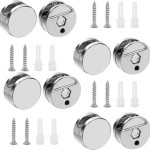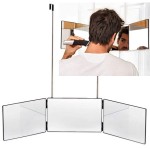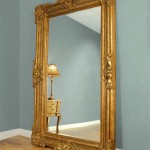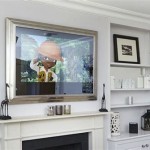The Timeless Allure of the Vintage Cheval Mirror
The cheval mirror, a full-length mirror mounted on a pivoting frame, represents a distinct and enduring element of interior design. Its origins can be traced back to 18th-century France, where it served as a practical yet elegant dressing aid for the aristocracy. While contemporary adaptations exist, vintage cheval mirrors retain a unique appeal, embodying historical craftsmanship, aesthetic sophistication, and a sense of timelessness that resonates with collectors and design enthusiasts alike.
The term "cheval" itself is French for "horse," referencing the fact that the mirror is supported by legs or trestles, much like a sawhorse. This ingenious design allows for the mirror to be tilted, providing the user with adjustable angles and a comprehensive view of their reflection. The cheval mirror quickly transcended its utilitarian function, becoming a statement piece that reflected the affluence and taste of its owner. Today, vintage examples offer insight into bygone eras and provide a tangible link to the past.
Identifying a genuine vintage cheval mirror involves careful consideration of several key characteristics, including the materials used, the style of the frame, the presence of original hardware, and any signs of wear commensurate with age. Understanding these elements is crucial for accurately assessing the mirror's authenticity and value.
Key Point 1: Distinguishing Features and Historical Context
Vintage cheval mirrors are characterized by several features that differentiate them from their modern counterparts. The materials used in their construction are often indicative of their age. For example, mirrors from the 18th and 19th centuries typically feature frames crafted from solid hardwoods such as mahogany, walnut, or oak. These woods were favored for their durability, rich grain patterns, and ability to be intricately carved. The presence of veneers, thin layers of wood applied to a less expensive substrate, can also provide clues about the mirror's period. Early veneers were often hand-cut and displayed a level of detail that is rarely seen in modern production. The mirror glass itself can also be a valuable indicator. Older mirrors often exhibit subtle imperfections, such as slight waviness or spotting, which are a result of the manufacturing processes used at the time. These imperfections, while not always desirable in a modern mirror, are considered character marks that enhance the authenticity of a vintage piece.
The historical context surrounding the creation of the mirror is also essential. Different periods and styles influenced the design of cheval mirrors. For instance, those crafted during the Rococo era (roughly 1730-1760) are characterized by ornate carvings, asymmetrical shapes, and elaborate gilded detailing. Mirrors from the Neoclassical period (1760-1790) tend to be more restrained, featuring clean lines, symmetrical designs, and classical motifs such as acanthus leaves and fluted columns. Victorian cheval mirrors (1837-1901) were often heavily embellished with elaborate carvings, dark finishes, and a blend of different styles. Understanding these stylistic nuances allows collectors to more accurately date and attribute the mirror to a specific period.
Examining the hardware of the cheval mirror can provide further insights. Original hinges, screws, and locking mechanisms are often made of hand-forged iron or brass. These components will typically display signs of age and wear, such as oxidation or pitting. Replacing original hardware can significantly diminish the value of a vintage mirror, so it is important to carefully inspect these details. The back of the mirror frame may also reveal clues about its history. Original backing boards are often made of solid wood and may be attached with hand-cut nails or screws. Any repairs or alterations made to the back of the mirror can provide valuable information about its provenance.
Key Point 2: Assessing Condition and Restoration Considerations
The condition of a vintage cheval mirror is a critical factor in determining its value and desirability. While some degree of wear and tear is to be expected in an antique piece, excessive damage can significantly detract from its appeal. Common issues to look for include cracks, chips, or scratches in the mirror glass; damage to the frame, such as missing carvings or loose joints; and deterioration of the finish, such as flaking paint or worn gilding.
The presence of silvering issues in the mirror glass is a particularly common concern. Silvering is the process of applying a reflective coating to the back of the glass, and over time, this coating can deteriorate, resulting in dark spots or a cloudy appearance. While minor silvering issues may be considered acceptable in a vintage mirror, extensive damage can significantly impair its functionality and aesthetic appeal. Replacing the mirror glass with a modern reproduction is an option, but it can also diminish the mirror's authenticity and value. Therefore, it is important to carefully weigh the pros and cons of replacing the glass.
Restoration of a vintage cheval mirror should be approached with caution. The goal of restoration is to preserve the mirror's original character and integrity while addressing any structural or cosmetic issues. Over-restoration, such as stripping the original finish or replacing original hardware, can significantly detract from the mirror's value. It is generally recommended to consult with a qualified antique restorer who has experience working with similar pieces. A skilled restorer can provide guidance on the best course of action and ensure that any repairs or alterations are carried out in a manner that is sympathetic to the mirror's original design.
Cleaning a vintage cheval mirror should be done with care. Harsh chemicals and abrasive cleaners can damage the finish of the frame and the surface of the mirror glass. It is generally recommended to use a mild soap and water solution to gently clean the frame, and a soft cloth to wipe the mirror glass. Avoid using excessive moisture, and be sure to dry the mirror thoroughly after cleaning.
Key Point 3: Placement and Styling in Contemporary Interiors
Despite their historical origins, vintage cheval mirrors can be seamlessly integrated into contemporary interiors. Their timeless elegance and versatility make them a valuable addition to a wide range of spaces, from bedrooms and dressing rooms to hallways and living areas. The key to successfully incorporating a vintage cheval mirror into a modern setting is to carefully consider its placement and styling.
In a bedroom or dressing room, a cheval mirror can serve as a functional and decorative element. Position it near a window to maximize natural light and create a bright and inviting space. Alternatively, place it in a corner to create the illusion of more space. When styling the mirror, consider adding a small bench or ottoman nearby to create a comfortable and inviting dressing area. You can also accessorize with decorative objects such as jewelry boxes, perfume bottles, or small plants to add a personal touch.
In a hallway or entryway, a cheval mirror can serve as a striking focal point. Position it opposite a source of light to reflect and amplify the natural light throughout the space. You can also use it to create a sense of depth and perspective in a narrow hallway. When styling the mirror, consider adding a small console table or side chair nearby to create a functional and stylish vignette. You can also hang artwork or other decorative objects on the wall behind the mirror to add visual interest.
In a living area, a cheval mirror can serve as a statement piece that adds a touch of elegance and sophistication to the space. Position it near a fireplace or other architectural feature to create a focal point. You can also use it to reflect and amplify the natural light in the room. When styling the mirror, consider placing it behind a sofa or armchair to create a sense of depth and dimension. You can also accessorize with decorative pillows, throws, or other textiles to complement the mirror's style.
Ultimately, the placement and styling of a vintage cheval mirror should reflect your personal taste and complement the overall design aesthetic of your home. By carefully considering these factors, you can create a space that is both stylish and functional, showcasing the timeless beauty of this enduring piece of furniture.
The enduring appeal of the vintage cheval mirror lies in its ability to transcend mere functionality and become a symbol of elegance, history, and personal style. Understanding its defining characteristics, condition considerations, and placement potential enables informed appreciation and integration into modern living spaces.

Vintage Cheval Mirror Wells Reclamation

Vintage Cheval Mirror Oak Standing Floor Tilting Vanity Boudoir Dressing Room Shabby Chic Traditional
Huge Victorian Cheval Mirror Large Tilting Dress 2950 00 Yvonne Sanders Antiques Ltd Auckland Furniture

Antique Cheval Mirrors

Antique French Style White Finished Cheval Mirror Mirrors Furniture Bedroom

Vintage 1960 S Mid Century Cast Brass Cheval Beveled Floor Mirror Original Cond
Edwardian Oak Cheval Mirror Treasure Trove Antiques Castlebridge Wexford Antique Vintage Furniture

Brass Cheval Mirror With Oval Frame 1960s Intondo

Antique Victorian Quality Figured Mahogany Free Standing Cheval Mirror In Mirrors

Vintage Full Length Mirror Wells Reclamation








